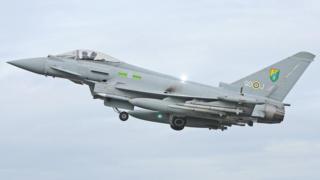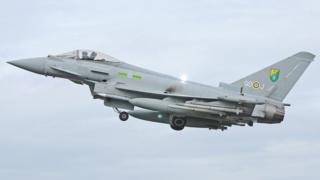Sonic boom: People woken by loud noise which ‘shook houses’
Royal Air Force Typhoons went supersonic on Sunday morning to investigate an unresponsive aircraft. …

 Image copyright PA
Image copyright PA A sonic boom has woken people and shaken houses across parts of London and the northern Home Counties.
People tweeted that a loud “explosion” had woken them at about 04:20 GMT – with houses shaking and reports of police sirens straight after.
The noise was generated by two Royal Air Force Typhoons, which launched from Coningsby in Lincolnshire and intercepted an unresponsive aircraft.
The sonic boom was heard across London, Hertfordshire and Bedfordshire.
London’s Metropolitan Police subsequently confirmed the bang was the result of the RAF aircraft being cleared to go faster than the speed of sound.
RAF jets are only given permission to go supersonic in emergencies, usually when they are required to intercept another aircraft.
“Typhoon aircraft from RAF Coningsby were scrambled this morning, as part of the UK’s Quick Reaction Alert (QRA) procedures, after an aircraft lost communications in UK airspace,” an RAF spokeswoman said.
“The aircraft was intercepted and its communications were subsequently re-established.”
She added the Typhoons had since returned to their base.
Mil Radar, which monitors RAF activity, tweeted when the jets were scrambled:
Janet, from Hertfordshire, told the BBC she heard a “huge thud” and felt her house shake at 04:17 GMT.
She wondered whether her boiler had blown up or a tree had fallen on the house, she said.
“I got up, looked around and out of the window, things looked fine,” she said.
“I went downstairs, went from room to room looking for cracks in the walls and ceilings.”
She went outside with a torch to check her roof and then checked the nearby road to see if there had been a crash, but saw “nothing and no sign of anyone else investigating”, she said.
Kiran Topan tweeted this video:
Actor Logan Dean tweeted that he was among those who heard the noise:
What causes a sonic boom?
When an aircraft approaches the speed of sound (768mph or 1,236km/h), the air in front of the nose of the plane builds up a pressure front because it has “nowhere to escape”, said Dr Jim Wild of Lancaster University.
A sonic boom happens when that air “escapes”, creating a ripple effect which can be heard on the ground as a loud thunderclap.
It can be heard over such a large area because it moves with the plane, rather like the wake on the bow of a ship spreading out behind the vessel.




